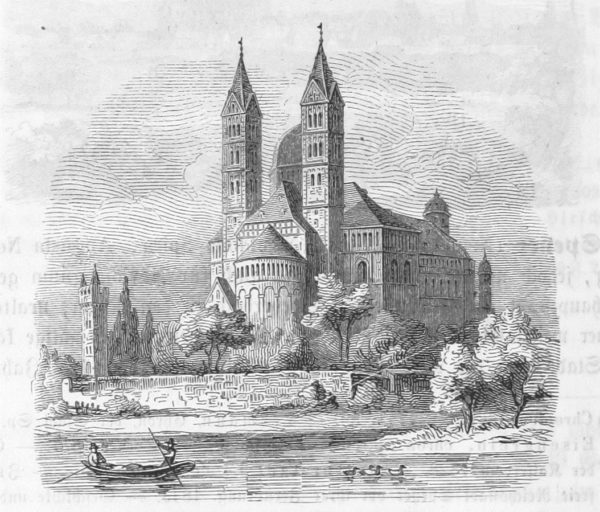Jeanne-Marie Musto retains copyright to this dissertation. Due to copyright restrictions, illustrations have been omitted. Download the complete dissertation here.
Byzantium in Bavaria:
Art, Architecture and History between Empiricism and Invention in the Post-Napoleonic Era
Jeanne-Marie Musto
December, 2007
Submitted to the Faculty of Bryn Mawr College in partial fulfillment of the requirements for the degree of Doctor of Philosophy

East end of Speyer Cathedral, seen from the Rhine
Image from Pleickhard Stumpf, Bayern. Ein geographisch-statistisch-historisches Handbuch des Königreiches (1852), p. 450.
Download the complete dissertation here or click on a chapter heading below to download that chapter.
- Chapter One. Introduction
- Byzantiums Tangible and Transcendent 6
- Overview of the Corpus of Bavarian Byzantium 18
- Methodology and Primary Sources 23
- Interpretive Approach 27
- Secondary Sources 31
- Geopolitical and Confessional Framework 36
- Imitation vs. Emulation 43
- Stylistic Terminology 49
- Organization 80
- Chapter Two. Historical Framework
- Ludwig as Crown Prince of the New Kingdom of Bavaria 85
- Restoration Bavaria and the Greek War of Independence 88
- The July Revolution and a Bavarian on the New Greek Throne 92
- German Byzantium between the Classical and Gothic ideals 93
- Enlightenment vs. Byzantium 95
- Romantic Byzantium 98
- Art and Architectural History as Geography 107
- The Brotherhood of St. Luke 108
- The Stability of Early Nineteenth-Century Byzantiums 111
- Chapter Three. Byzantium between Ancient and Modern
- Ludwig in Italy: From Classical Greece to Byzantium 113
- The German Search for Byzantium 117
- An Italo-German Byzantium 122
- The First Bavarian Byzantine Renovation: Speyer Cathedral 124
- Ludwig and the Palatine Chapel in Palermo 135
- Ludwig Inherits the Bavarian Throne 138
- Art from the East: The Pinakothek Loggias 140
- A Bavarian Byzantine Revival Begins: the Allerheiligenhofkapelle 146
- Heß’s, Schraudolf’s and Schwarzmann’s Byzantine Revival Frescoes 160
- Reception of the Allerheiligenhofkapelle 168
- Klenze’s Model Byzantine Church: St. Michael and John the Baptist, Eltmann 166
- Klenze’s Western Byzantium: St. Salvator, Donaustauf 172
- Chapter Four. Byzantine vs. Gothic Polychromy: Ludwig’s Restoration of Bamberg’s Cathedral of St. Peter and St. George
- Ludwig I’s Program to Undo Bamberg’s Post-Medieval Polychromy 181
- Early Nineteenth-Century Appreciation of Medieval Polychromy 192
- Ludwig’s Early Fascination with Classical Polychromy 203
- Crown Prince Ludwig’s Early Explorations of Medieval Polychromy in Tandem with Late Classicizing Renovations at Bamberg Cathedral 208
- Byzantine Bamberg 1. Rupprecht Discovers Traces of Medieval Paint 218
- Byzantine Bamberg 2: The Restoration under Heideloff 234
- Byzantine Bamberg 3: Gärtner Takes Over 245
- The Little Byzantine 250
- German Style Stained Glass and Classical Purity 255
- Byzantine vs. German to Romanesque vs. Gothic 257
- Chapter Five. Eastern vs. German Byzantine
- Ludwig of Bavaria and His Crusading Patron Saint: Louis IX of France 261
- The Ludwigskirche (1828-1844): the Commissions 264
- The Byzantine Style: Orthodox or Pre-Reformation Catholic? 266
- Friedrich Wilhelm III of Prussia and the New Greek Chapel of St. Alexander Nevsky, Potsdam (ca. 1826-28) 270
- Ludwig’s Catholic Philhellenism: Klenze Renovates St. Salvator, Munich, as a New Greek Church (1828-30) 273
- Ludwig, Gärtner and the Purified Byzantine Style 275
- Cornelius’s Christian Vision: Byzantine? 277
- Cornelius’s Christian Vision and Confessional Polarization 284
- Bavarian Byzantine Glazing 287
- The Evolution of Gärtner’s Architectural Ideas 290
- The Ludwigskirche on the Ludwigsstraße: A Byzantine Heart for Bavaria’s New Political and Intellectual Establishment 295
- Gärtner Approaches Byzantium 296
- Klenze Evaluates Gärtner’s Plans: Style as Confessonal Politics 301
- Parallels between Gärtner’s Ludwigskirche and Klenze’s Byzantine Style 304
- Gärtner’s Purified Byzantine Style and Winckelmann’s Call to Imitation 308
- Gärtner’s Changes to the Approved Ludwigskirche Façade 310
- The Ludwigskirche’s Ornamental Fresco Program 314
- Reception of the Ludwigskirche as Byzantine 329
- Chapter Six. Conclusion and Significance of Bavarian Byzantium
- Bavarian Byzantium in the 1830s: Confessional Politics in Greece and the Emergence of Competing Byzantiums 334
- From the Bavarian Byzantine to the Russian Byzantine Revival Style 343
- Ludwig’s Creation of a Second Historicizing Style for Synagogues and its Impact on the Spread of the Byzantine Revival Style 357
- Semper’s and Rosengarten’s Byzantine Synagogues in Dresden and Kassel 374
- Ludwig’s Last Essay in the Byzantine Revival: The Interior of Speyer Cathedral (and Mannheim Synagogue) 378
- The Transition to Romanesque: Hübsch’s Westwork at Speyer Cathedral 389
- Conclusion. Ludwig I’s Byzantium: Between Empiricism and Invention 394
- Bibliography 399
- List of Plates
- Maps 425
- Illustrations 426